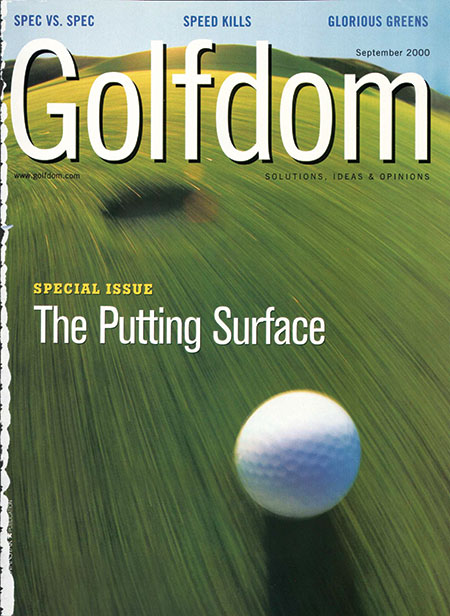Golfdom Files: To infinity and beyond

September 2000 cover (Photo: Golfdom archives)
Technology has come a long way since the world rang in the new millennium more than two decades ago, as is clear from this September 2000 article, where superintendents discuss elements they’d like to see incorporated into greens mowers — GPS sensors, disease-sensing monitors and more — elements that have since become common on a wide swath of golf course technology. Check out the cover story here to find out just exactly how far technology and software have bounded ahead in the golf course world.
In a country where Buck Rodgers and Captain Kirk fueled expectations of what technological advances future centuries might hold, it’s no surprise that superintendents expect greens mowers in the 21st century to follow a similar path.
Superintendents want future mowers to cut with lasers, be controlled by satellites and fix themselves. Heck, one superintendent even wants his greens mower to make coffee for him in the morning.
While the coffee idea might be a stretch, the rest of the high-tech gadgets superintendents expect to see on greens mowers might not be so pie in the sky.
Companies are conducting intense research into alternative power supplies, disease-sensing monitors and the possibility of integrating mower controls with the Global Positioning System (GPS).
Experts say the real question is not whether these innovations are possible, but when superintendents can start using them.
Helmut Ullrich, marketing manager for Toro’s Greensmasters line of mowers, says one superintendent with whom he spoke described the perfect mower of the future.
“He said the perfect greens mower should be a solar-powered hovercraft with a laser that will cut the grass to the ideal height to get the most speed on the greens,” Ullrich says. “Were not quite to that point, but we’re definitely making strides on a lot of fronts.”
Ullrich says mowers in the new century will probably move from fixed cutting decks to flexible ones, and he said mowers will have narrower profiles as well. Those adjustments will help superintendents mow at lower heights because the machines will hug the contours of the greens more closely. It’s the same theory that propels most razor innovations — the closer the blade hugs the surface, the closer the cut.
Mowers will also become more operator friendly, a factor that’s increasingly important in a world of frequent employee turnover, Ullrich says. “We want to create a mower where the operator can diagnose problems and fix them, possibly without a mechanic,” Ullrich says.
Integrating mowers into GPS is something all companies are exploring. Chuck Greif, manager of worldwide golf and turf market development for John Deere Co., says such robotic mowers are about 10 years away, but it’s not for a lack of trying. Computer technology will have a great impact on how mowers of the future will operate.
Not only will mowers cut grass without operators, but they will also have a feature called parallel tracking, which will guarantee straight lines on the greens, Greif says. It would allow superintendents to mow greens by remote late at night, knowing that they won’t be destroyed in the process.
Mowers will also include sensors to track fungal development and nutrient levels on greens. Combined with the latest computer technology, these mowers will transmit such data to superintendents, allowing them to adjust pesticide and fertilization plans accordingly, Greif says.
Greif adds that the speed of the rollouts depends on how many industries can work together to develop new technologies. For example, alternative power sources that can also be applied to the auto industry will reach the market faster than optical disease sensors. “A lot of the technology to do these things exists now,” Greif says.
“You have to balance the costs of how much it will take to bring a feature to market with how much the market will be willing to pay,” Greif says. “Otherwise, your investment won’t pay off.”










